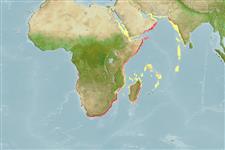Common names from other countries
>
Eupercaria/misc (Various families in series Eupercaria) >
Sparidae (Porgies)
Etymology: Diplodus: Greek, diploos = twice + Greek, odous = teeth (Ref. 45335).
Environment: milieu / climate zone / depth range / distribution range
Οικολογία
Θαλασσινό(ά) Υφαλόφιλο(α); εύρος βάθους 0 - 50 m (Ref. 27121). Tropical; - 35°S
Southeast Atlantic and Western Indian Ocean: Angola to Mozambique and southern Madagascar, possibly reaching Mauritius (Ref. 3168, 3198).
Length at first maturity / Μέγεθος / Βάρος / Age
Maturity: Lm 21.1 range ? - ? cm
Max length : 45.0 cm TL αρσενικό/απροσδιόριστο; (Ref. 3198); common length : 30.0 cm TL αρσενικό/απροσδιόριστο; (Ref. 3507); μεγ. αναφερόμενη ηλικία: 21 έτη (Ref. 26244)
Short description
Κλείδες προσδιορισμού | Μορφολογία | Μορφομετρία
Ραχιαίες άκανθες (συνολικά) : 12; Μαλακές ραχιαίες ακτίνες (συνολικά) : 14 - 15; Εδρικές άκανθες: 3; Μαλακές εδρικές ακτίνες: 13 - 14. Young specimens with fine crossbars; large adults almost uniformly black.
Adults occur in shallow rocky and sandy substrate; juveniles in shallow reefs, estuary mouths and intertidal pools, sandy beach surf zone. Omnivorous on seaweeds, sponges and bivalves. Also feeds on crustaceans, worms, mollusks, and fish. Sold fresh or whole and as bait.
Life cycle and mating behavior
Maturities | Αναπαραγωγή | Spawnings | Egg(s) | Fecundities | Προνύμφες
Bauchot, M.-L. and J.-C. Hureau, 1990. Sparidae. p. 790-812. In J.C. Quero, J.C. Hureau, C. Karrer, A. Post and L. Saldanha (eds.) Check-list of the fishes of the eastern tropical Atlantic (CLOFETA). JNICT, Lisbon; SEI, Paris; and UNESCO, Paris. Vol. 2. (Ref. 3688)
IUCN Red List Status (Ref. 130435)
CITES (Ref. 128078)
Not Evaluated
Threat to humans
Harmless
Human uses
αλιεία: περιορισμένης εμπορικότητας; αλιεία αναψυχής: ναί; δόλωμα: usually
Εργαλεία
Special reports
Download XML
Διαδικτυακές πηγές
Estimates based on models
Preferred temperature (Ref.
115969): 18.6 - 27, mean 25.9 (based on 56 cells).
Phylogenetic diversity index (Ref.
82804): PD
50 = 0.5000 [Uniqueness, from 0.5 = low to 2.0 = high].
Bayesian length-weight: a=0.01514 (0.00951 - 0.02409), b=3.08 (2.95 - 3.21), in cm Total Length, based on LWR estimates for this species & Genus-body shape (Ref.
93245).
Τροφικό Επίπεδο (Ref.
69278): 2.7 ±0.15 se; based on food items.
Ελαστικότητα (Ref.
120179): Μεσαίο(α), ελάχιστος χρόνος για διπλασιασμό πληθυσμού 1,4 - 4,4 έτη (tm=3; tmax=21).
Fishing Vulnerability (Ref.
59153): Moderate vulnerability (38 of 100).
